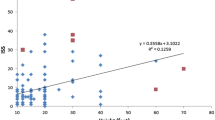Abstract
Background
The distribution of fractures in the spine reported in the literature is quite variable. Application of such data to the pediatric population needs to take into account differences between children and adults, including overall decreased fracture frequency in children, developmental and physiological differences, and mechanism of injury. Knowledge of specific regions of injury may alter search patterns and protocols.
Objective
To determine if the distribution of spinal injuries in pediatric patients is related to age, mechanism of injury, or gender.
Patients and methods
All pediatric patients (<18 years old) referred to our trauma service over a 5-year period were retrospectively reviewed. All patients with vertebral fracture and/or neurological injury were included. The levels of the spinal fractures were tabulated. Correlation was then made with age, gender, and mechanism of injury (motor vehicle accident versus non-motor vehicle accident).
Results
Of the 2614 pediatric patients, 84 sustained vertebral fracture and 50 had neurological injury without radiographic abnormality. A total of 164 fractures were identified. The thoracic region (T2-T10) was most commonly injured, accounting for 47 fractures (28.7%) followed by the lumbar region (L2-L5) with 38 fractures (23.2%), the mid-cervical region with 31 fractures (18.9%), the thoracolumbar junction with 24 fractures (14.6%), the cervicothoracic junction with 13 fractures (7.9%), and the cervicocranium with 11 fractures (6.7%). There was no relationship to gender or mechanism of injury.
Conclusions
Regardless of gender or mechanism of injury, the thoracic spine (T2-T10) is the most common region of fracture in pediatric trauma patients.




Similar content being viewed by others
References
Resnick DK, Simcha JW, Benszel EC (1997) Biomechanics of the thoracolumbar spine. Neurosurg Clin North Am 8:455–469
Moore KL, Dalley AF (1999) Clinically oriented anatomy, 4th edn. Williams and Wilkins, Baltimore, p 448
Vollmer DG, Banister WM (1997) Thoracolumbar spinal anatomy. Neurosurg Clin North Am 8:443–453
Criscitiello AA, Fredrickson BE (1997) Spinal trauma thoracolumbar spine injuries. Orthopedics 20:939–944
Weinstein SL (2001) The pediatric spine. Principles and practice, 2nd edn. Williams and Wilkins, Philadelphia, pp 35, 567, 593
Fon GT, Ptt MJ, Thies AC (1980) Thoracic kyphosis: range in normal subjects. Am J Radiol 134:979–983
Saboe LA, Reid DC, Davis LA, et al (1991) Spine trauma and associated injuries. J Trauma 31:43–47
Calenoff L, Cheschare JW, Rogers LF, et al (1974) Multiple level spinal injuries: importance of early recognition. AJR Am J Roentgenol 130:665–667
Kewalramani LS, Taylor RG (1976) Multiple non-contiguous injuries to the spine. Acta Orthop Scand 47:52–58
Evans DL, Bethem D (1989) Cervical spine injuries in children. J Pediatr Orthop 9:563–568
McGrory BJ, Klassen RA, Chao EYS, et al (1993) Acute fractures and dislocations of the cervical spine in children and adolescents. J Bone Joint Surg Am 75:988–995
Akbarnia BA (1999) Pediatric spine fractures. Orthop Clin North Am 30:521–536
Acknowledgement
We thank Dr. Alan Davis for statistical consultation.
Author information
Authors and Affiliations
Corresponding author
Rights and permissions
About this article
Cite this article
Reddy, S.P., Junewick, J.J. & Backstrom, J.W. Distribution of spinal fractures in children: does age, mechanism of injury, or gender play a significant role?. Pediatr Radiol 33, 776–781 (2003). https://doi.org/10.1007/s00247-003-1046-y
Received:
Revised:
Accepted:
Published:
Issue Date:
DOI: https://doi.org/10.1007/s00247-003-1046-y




